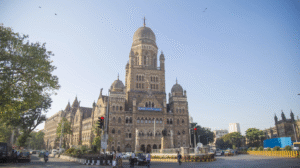Heritage groups, architects, and citizens object to the BMC’s plan to classify and redevelop “iconic” Mumbai structures.

Mumbai, July 24, 2025 The BMC iconic buildings policy is facing backlash from conservationists, architects, and residents across Mumbai. The controversy surrounds a proposed amendment to the Development Control and Promotion Regulation (DCPR) 2034. This amendment would introduce a new clause allowing redevelopment under a new “Iconic Buildings” category.
Critics argue the policy could harm Mumbai’s historic architecture. They are especially concerned about the lack of transparency and absence of strong safeguards in the proposal.
The BMC iconic buildings policy has raised serious doubts about the future of Mumbai heritage redevelopment. Many believe the move may not align with the city’s rich architectural legacy.
Under the proposed amendment, Regulation 33(9), the BMC plans to permit the redevelopment of both heritage and non-heritage buildings that meet specific aesthetic or locational criteria. According to officials, the BMC iconic buildings policy aims to boost tourism, strengthen cultural identity, and drive commercial development. They argue the initiative celebrates Mumbai’s built environment while enabling modernization. However, critics warn that it may undermine efforts toward responsible Mumbai heritage redevelopment, especially if the classification of “iconic” buildings remains vague or lacks proper oversight.
However, heritage experts have voiced strong objections. They argue the vague definition of “iconic” opens the door to arbitrary decisions. This could seriously endanger Mumbai’s historical architecture and compromise the integrity of Mumbai heritage redevelopment. Mumbai heritage redevelopment under this policy, they argue, could prioritize profit over preservation.
The Port Heritage Conservation Association has formally written to the BMC, calling for a withdrawal of the amendment. The group argues that redevelopment should not come at the cost of architectural and historical integrity. According to the Association, the BMC iconic buildings policy may open the door to widespread demolition, masked as beautification or modernization. This concern has found support from several respected groups. These include the Urban Design Research Institute, Oval Trust, Art Deco Mumbai Trust, and the Nariman Point Churchgate Citizens’ Association. All have warned that such measures could severely harm Mumbai heritage redevelopment efforts.
These groups have formed a working committee to analyze the implications of the proposal. Architect Sanjay Patil, who helped organize the expert panel, emphasized that the amendment needs far greater public and institutional scrutiny before it is adopted. “Mumbai’s architectural landscape is not just a skyline—it’s a story. The city’s buildings have meaning beyond their façades,” he said.
Opposition also stems from the BMC’s failure to consult the Heritage Conservation Committee before moving forward with the amendment.Experts argue that comparing Mumbai’s skyline to international landmarks—like The Shard in London or Marina Towers in Chicago—is misleading. They insist such comparisons ignore the city’s unique architectural heritage and cultural fabric. Many believe the BMC iconic buildings policy must reflect local context to protect Mumbai heritage redevelopment.“You can’t replicate global models without local context,” said a spokesperson for the Urban Design Research Institute.
Many stakeholders demand that the BMC first clarify what criteria will be used to designate a building as “iconic.” They also want to ensure that redevelopment will follow strict heritage preservation protocols. “We are not against development,” said an Oval Trust member. “We are against the reckless destruction of the past in the name of progress.”
As the controversy escalates, public opinion continues to sway toward caution. The Mumbai heritage redevelopment proposal now faces not only bureaucratic delays but also rising civic activism determined to defend the city’s irreplaceable charm.
Source
